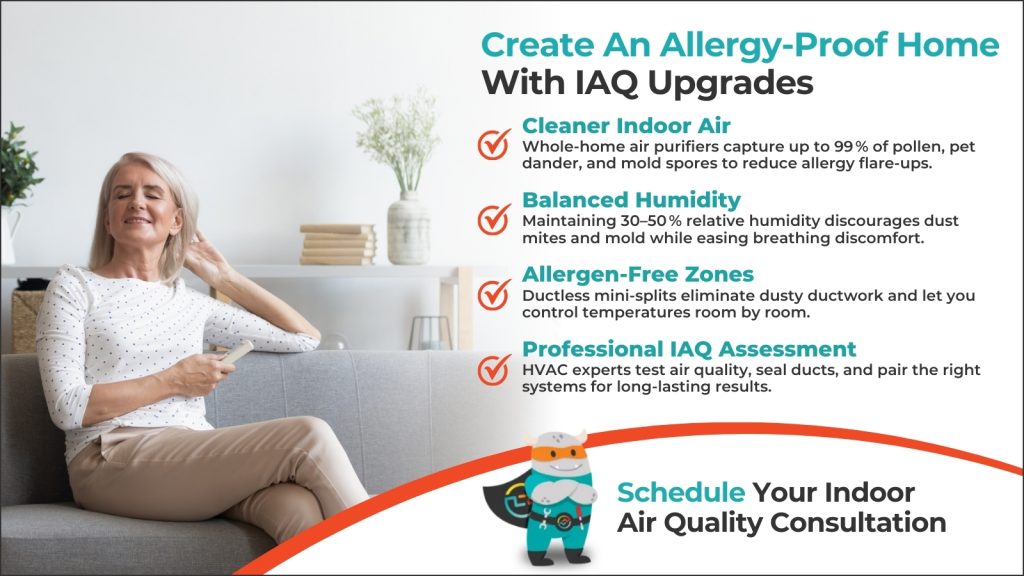Spring is in the air—and so are allergens. While warmer weather brings blooming flowers and outdoor fun, it also kicks allergy season into high gear. For many homeowners, escaping the sneezing, itchy eyes, and stuffy noses means heading inside.
But is your home truly the allergy-safe haven it should be? If pollen, dust, pet dander, or mold spores are sneaking into your living space, it’s time to take control with an indoor air quality upgrade. From air purifiers to ductless systems and humidity control, upgrading your HVAC setup can make a big difference in how you feel every day.

How Poor Indoor Air Quality Affects Allergy Symptoms
Most people think of allergies as an outdoor problem—but the truth is, indoor air can be two to five times more polluted than the air outside. That’s because allergens don’t just come in through open windows; they hitch rides on clothing, pets, shoes, and even air leaks. Once inside, they get trapped in your HVAC system and recirculate throughout your home. Common indoor allergens include:
- Pollen
- Pet dander
- Dust mites
- Mold spores
- Volatile organic compounds (VOCs)
If your HVAC system isn’t equipped to filter and manage these pollutants, you and your family may continue to suffer through allergy season—inside and out.
IAQ Solutions That Help You Breathe Easier
Air Purifiers
A high-efficiency air purifier can remove up to 99% of airborne particles, including pollen, pet dander, bacteria, and mold spores. Whole-home purifiers integrate directly with your HVAC system, providing round-the-clock protection across every room. Benefits include:
- Cleaner, healthier air
- Fewer allergy flare-ups
- Protection from bacteria and viruses
Ductless HVAC Systems
If your home uses ducted heating and cooling, your ductwork could be harboring allergens and dust. A ductless mini-split system provides heating and cooling without circulating air through dirty ducts—making it a great choice for allergy-sensitive households. Benefits include:
- No ductwork = fewer places for allergens to hide
- Zoned temperature control
- Quiet, efficient operation
Humidity Control
Allergens like dust mites and mold thrive in high-humidity environments. On the flip side, air that’s too dry can irritate nasal passages. The key is balanced humidity—typically between 30–50%. Upgrading your HVAC system with a whole-home humidifier or dehumidifier helps create the ideal indoor environment for comfort and allergy relief. Benefits include:
- Reduces mold and dust mite growth
- Improves breathing comfort
- Preserves wood furniture and flooring
Why a Professional Indoor Air Quality Upgrade Matters
While portable air purifiers and standalone humidifiers offer some relief, a whole-home IAQ solution offers comprehensive and long-lasting results. An HVAC professional can assess your home’s air quality and recommend the best combination of systems for your specific needs. This might include:
- Upgrading to HEPA or highly rated MERV-rated filters
- Installing an advanced air purification system
- Sealing and cleaning ductwork
- Balancing humidity levels
- Replacing outdated HVAC components with allergy-friendly options
Don’t Let Allergies Take Over Your Spring
This year, take a proactive step toward cleaner, healthier air. Whether you’re sensitive to seasonal pollen or dealing with year-round indoor triggers, the right IAQ upgrade can transform your home into a true comfort zone.
To schedule your indoor air quality service, contact Premier HVAC Services today!


